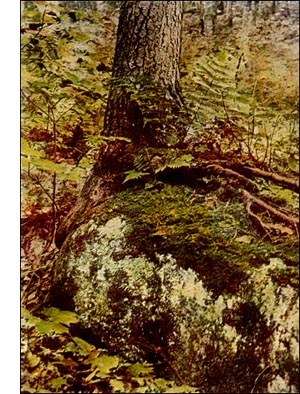Genus Dicranum
 Genus DICRANUM, Hedw.
Genus DICRANUM, Hedw.The species of this genus are universally distributed, and include some of our most easily recognised mosses. They usually grow in dense tufts or cushions on the ground or on old decaying logs or even on rocks. About two hundred and thirty-four species are known in all ; about sixty-three are found in North America, six of these within the limits of New York City.
Their showy dark-green or glossy yellow-green cushions are often conspicuous in damp shady places and consist of numerous more or less erect and forking stems, often crowded together and covered with a felt of reddish hairs at least below, with lance-shaped often curved leaves above that spread all about the stem or turn to one side.
The leaves have a slender apex with a vein usually broad and extending into the apex. The character of the vein and the cellstructure are relied upon for perfect classification of the species. The cells vary from short to linear oblong in the upper part of the leaf, to long and narrow in the lower part; four-sided, inflated, orange or brown, in the angles of the base. The leaves at the base of the pedicel are sheathing and abruptly pointed. The spore-cases are erect or turned to one side, the base, which is often swollen so as to be unsymmetrical, tapers to an erect pedicel, long and smooth. An annulus is generally present. The lid is conical with a long beak. The peristome is single, of sixteen teeth, two-cleft to the middle and red-brown at the base.
The name of the genus is derived from a Greek word; a flesh-hook or fork, from a supposed resemblance of its teeth to that instrument. The American Indians call Forkmosses "Women's heads," "because when you trample them under foot they spring right up again."
Although at first glance the Dicranums appear to have their spore-cases on the sides of the plants, they truly belong to the group of mosses which bears them on the summits of the stems (acrocarpi) and not to the group which bears them on the sides of the stems (pleurocarpi), for a closer examination shows that a side stem grows on after the spore-case has begun to develop, leaving the spore-case and pedicel behind on the apex of the main stem. The felt of hairs on the stems serves as a sponge through which water may creep to the upper parts of the plants.
Broom Moss
Whip Fork Moss